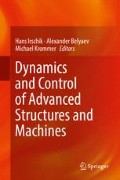Abstract
The paper evaluates the effect of various modelling strategies for the bridge–train interaction system on the prediction of the dynamic bridge response. Trains crossing the bridge with constant high-speed are described either by a series of moving single forces representing their static axle loads or by a planar mass-spring-damper multi-body system. The outcomes of the latter model serve as reference solution because vehicle–bridge interaction (VBI) is explicitly considered. In an application problem the vertical bridge peak response is derived based on models of different degree of sophistication. From the outcomes it can be concluded that the impact of high-speed trains on a bridge by means of single forces (representing the static train axle loads) provides accurate results if bridge damping is increased and additional dynamic distributed mass is added to the bridge to account indirectly for VBI effects.
Access this chapter
Tax calculation will be finalised at checkout
Purchases are for personal use only
References
Adam C, Salcher P (2013) Dynamic effect of high-speed trains on simple bridge structures. Struct Eng Mech 51:581–599
Doménech A, Museros P, Martínez-Rodrigo MD (2014) Influence of the vehicle model on the prediction of the maximum bending response of simply-supported bridges under high-speed railway traffic. Eng Struct 72(C):123–139
Eurocode 1 (2003) Eurocode 1: EN 1991–2: actions on structures
Kouroussis G, Conti C, Verlinden O (2012) A comparison of environmental vibratory effects of railway rolling stock using a compound multibody-finite element model. In: Pombo J (ed) Proceedings of the first international conference on railway technology: research, development and maintenance (railways 2012), Las Palmas de Gran Canaria, Spain, 18–20 April 2012, paper no. 124, 19 pp
Liu K, De Roeck G, Lombaert G (2009) The effect of dynamic train–bridge interaction on the bridge response during a train passage. J Sound Vib 325(1–2):240–251
Mähr TC (2008) Theoretische und experimentelle Untersuchungen zum dynamischen Verhalten von Eisenbahnbrücken mit Schotteroberbau unter Verkehrslast (in German). Doctoral thesis, TU Vienna
ÖBB Infrastruktur (2011) ÖBB Infrastruktur: Richtlinie für die dynamische Berechnung von Eisenbahnbrücken (in German)
Rigueiro C, Rebelo C, da Silva LS (2010) Influence of ballast models in the dynamic response of railway viaducts. J Sound Vib 329(15):3030–3040
Salcher P (2015) Reliability assessment of railway bridges designed for high-speed traffic: modelling strategies and stochastic simulation. Doctoral thesis, University of Innsbruck
Salcher P, Adam C (2013) Modelling strategies for bridges subjected to high-speed trains. In: Adam C, Heuer R, Lenhardt W, Schranz C (eds) Proceedings of the Vienna Congress on Recent Advances in Earthquake Engineering and Structural Dynamics (VEESD 2013), Vienna, Austria, 28–30 August 2013, paper no. 94, 10 pp
Salcher P, Adam C (2015) Modeling of dynamic train-bridge interaction in high-speed railways. Acta Mech 226(8):2473–2495
Yang YB, Yau JD, Wu YS (2004) Vehicle-bridge interaction dynamics. With applications to high-speed railways. World Scientific Publishing Company Incorporated, Singapore
Author information
Authors and Affiliations
Corresponding author
Editor information
Editors and Affiliations
Rights and permissions
Copyright information
© 2017 Springer International Publishing Switzerland
About this chapter
Cite this chapter
Adam, C., Salcher, P. (2017). Effect of the Load Modelling Strategy on the Dynamic Response Prediction of Bridges Subjected to High-Speed Trains. In: Irschik, H., Belyaev, A., Krommer, M. (eds) Dynamics and Control of Advanced Structures and Machines. Springer, Cham. https://doi.org/10.1007/978-3-319-43080-5_24
Download citation
DOI: https://doi.org/10.1007/978-3-319-43080-5_24
Published:
Publisher Name: Springer, Cham
Print ISBN: 978-3-319-43079-9
Online ISBN: 978-3-319-43080-5
eBook Packages: EngineeringEngineering (R0)

